

|
by Joseph Brennan. Copyright 2001, 2002. |
38 StPassenger service: 1870 to 1935.Existing abandoned portions: platforms and stairs to street, in what is now a road tunnel Touring: Drive through the Park Ave tunnel northbound. The stairs up from the walled-up platforms are visible near the north end of the tunnel. construction and operationThe station is in the old Park Avenue tunnel. The New-York and Harlaem Rail-road (sic), the first railroad in the city, built an open cut through Murray Hill in the line of Park Ave, opened 1 May 1834. By an act passed in 1850, the City allowed the railroad to roof over the cut from the southerly line of 34 St to the northerly line of 39 St, and to build stone retaining walls otherwise for a grade separated route from the northerly line of 32 St to the southerly line of 42 St. The work was in progress in August 1852. The tunnel was for the steam trains from the railroad's 27 St terminal. The cars were pulled by horses from the terminal to 32 St. Along with the tunnel, the company built a "station" on the east side of Park Ave at 32 St, for car storage and crew quarters, and possibly originally as an engine terminal as well. The same company operated city horsecars from its downtown terminus at Park Row and Broadway up to at least 28 St. In 1858 the New York and Harlem obtained a franchise for a new parallel line turning off at 42 St and running up Madison Ave to 79 St (and later to the Harlem River). The city cars used this route from its opening in July 1870, sharing the tunnel with steam trains. The steam and horse divisions were not separated until the opening of Grand Central Depot in 1871, and even then for a time there was an opening in the 42 St wall of the depot with two tracks crossing from the street into the station. The station at 38 St was created for the horsecar service, to reduce the long gap from 30 St to 42 St. The company dug down from the street and removed a section of arch, and installed granite stairways down to track level. Stations were also provided in the cuts just outside the ends of the tunnel, at 34 St and 40 St. The stations were open by October 1870. From 1871, the New York and Harlem operated only horsecars in the Park Ave tunnel and approaches. The street railway was converted to electric conduit operation in 1898. When streetcar service was abandoned in 1935, the bus replacement ran at street level, and the tunnel was closed while being converted into a road tunnel. The road tunnel opened in October 1937. For road traffic, the tunnel grade was ramped up steeply from 39 St to 40 St to provide a direct route for cars into the viaduct that starts at 40 St and runs around Grand Central Terminal. The viaduct had been built in 1919 above the old streetcar tunnel entrance that rose from 40 St to street level at 42 St. Now the tunnel and viaduct provide a narrow but continuous express route for one lane in each direction from 32 St to 45 St with only one street crossing at 40 St. During this work evidence of the stations at the ends of the tunnel was eliminated. The platforms at 38 St were still visible till some time in the 1990's. From each platform, a stairway rose northward to a landing, and then the two stairways turned and rose toward each other to a common landing over the road. New wall and ceiling surfaces now hide the platforms and the upper part of the stairway, continuing the line of the wall and ceiling elsewhere in the tunnel. Part of the stairs rising north can still be seen. |
diagram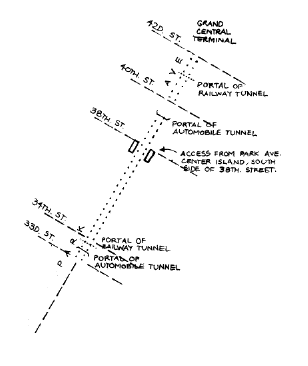
The tunnel today runs from 33 St to 39 St. |
|
In a view looking uptown from 32 St in 1919, the railroad still dominates Park Ave, with the wall of the cut at left, the tunnel portal ahead at 34 St, and the carbarn at right. Past the carbarn is a huge stone armory building, and in front of it a subway kiosk to the uptown side of 33 St station. Source unknown, Edward B Watson collection, from Alan Paul Kahn, The Tracks of New York, Number 1, Metropolitan Street Railway 1907, New York: Electric Railroaders' Association, 1973. |
|
|
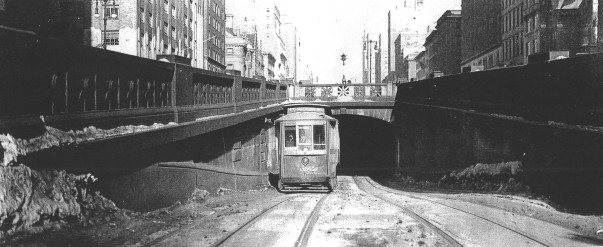
|
Park Ave was rebuilt around the south portal in the 1920's to make it more suitable to automobile traffic. The tracks now followed the street grade as far as 32 St, and then went down into a narrow cutting with cut stone walls. Here, a shabby looking conduit car emerges from the tunnel in 1934. Photo copyright by Charles Wrege. |
|
|
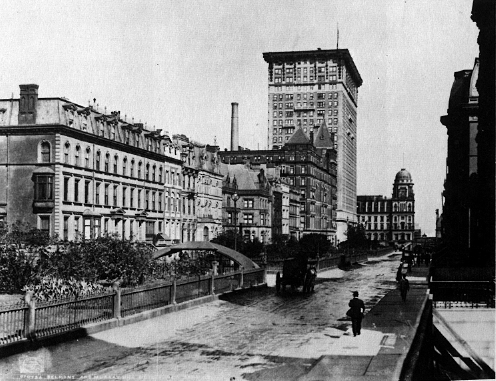
|
Moving north, a view uptown from 37 St circa 1904 reveals a structure in the center mall of Park Ave on the south side of 38 St. At the end of Park Ave in the distance is the Grand Central Depot as remodelled in 1892. To its left is the tall Belmont Hotel, 1904. Source unknown, Cityana collection, from Benjamin Blom, New York: Photographs 1850-1950, New York: E P Dutton, 1982 (an Amaryllis Press Book). |
|
Again moving north, a view uptown from 41 St in 1887 shows the tracks coming up to street level in front of Grand Central Depot. The arched opening connecting the steam and horse divisions is still there, and a train can be seen in the shed. The city cars turned left here to cut over to Madison Ave to continue north. Source unknown, Edward B Watson collection, from Edward B Watson, New York Then and Now, New York: Dover Publications, 1976. |
|
A detail of the photo above is the best known evidence for a station at 38 St. The roof looks fairly permanent although the curving sections on each side are highly unusual. |
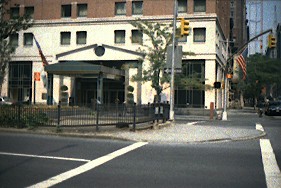
Today, there is still an opening at the same location, covered by a metal hatch. (The faded sign appears to be about the plantings in the mall.) |
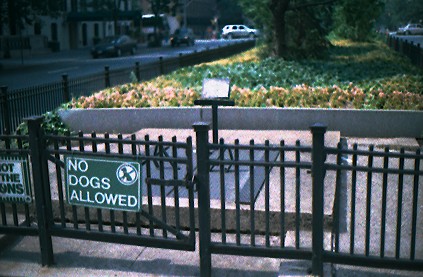
|
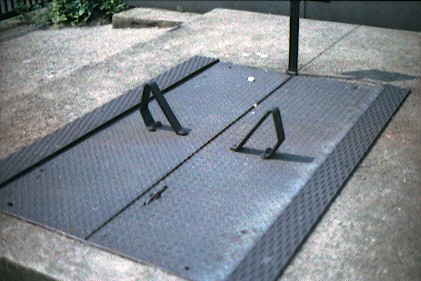
|